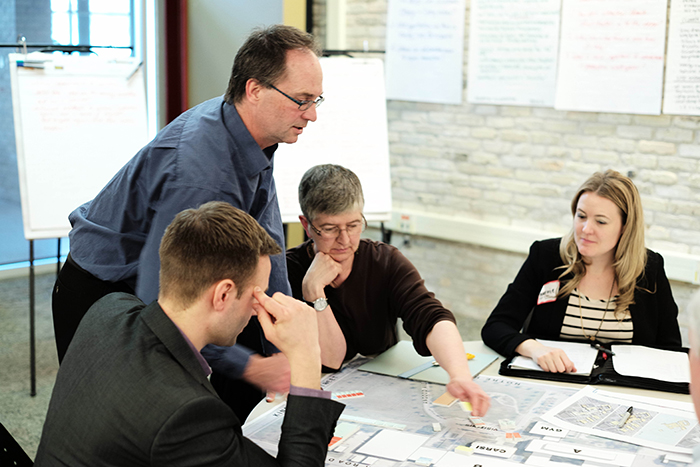
By Marnie Gartrell, Architect
With many Manitoba workplaces carefully re-opening their doors and some pandemic restrictions loosening, the desire to move forward in these uncertain times, and dealing with the stress of that uncertainty, is about the only certainty we can count on right now!  This graphic adapted from the Spectrum of Public Participation (c) International Association for Public Participation www.iap2.org
This graphic adapted from the Spectrum of Public Participation (c) International Association for Public Participation www.iap2.org
 In this unchartered territory, design teams are grappling with questions about how best to communicate and engage with stakeholders unsettled by the COVID-19 crisis. Public Participation (P2) engagement strategies are based on the belief that “those who are affected by a decision have a right to be involved in the decision-making process.” The importance of inclusion, collaboration and access cannot be underestimated in this time of social distancing and self-isolation.
In this unchartered territory, design teams are grappling with questions about how best to communicate and engage with stakeholders unsettled by the COVID-19 crisis. Public Participation (P2) engagement strategies are based on the belief that “those who are affected by a decision have a right to be involved in the decision-making process.” The importance of inclusion, collaboration and access cannot be underestimated in this time of social distancing and self-isolation.
At the best of times, group decision making requires planning, patience, humor, and hard work. When we physically get together, we sense nuance, we focus, empathize, anticipate, and read one another. This “togetherness” facilitates probing deeper into observations to solve the problems that ultimately drive design thinking. With physical distancing remaining the norm for the short-medium term, design teams are having to quickly adapt to implement innovative solutions that engage stakeholders in creative, inclusive, and strategic ways. There is, of course, no one right way to do this. So, where do we begin?
Is my Ask too big?![]()
First off, how receptive will your target audience be to your invitation to a participation process? Is your “Call to Action” compelling? With many people struggling on reduced incomes, with unemployment, and juggling childcare and homeschooling responsibilities, it may make more sense to first ask how best the design team can support stakeholders in this moment, rather than the other way around. Are there existing initiatives in place that can be supported to form a mutually beneficial partnership? Partnerships strengthen connections with stakeholders by sharing power and fostering the exchange of information resulting in a richer knowledge gathering process.![]() Tweak your Tech Toolbox
Tweak your Tech Toolbox
Interactive online technologies have incredible power to connect people. Where would we be now without virtual meetings (Facetime, Zoom, Skype, Google Docs and the rest) enabling us to meet, work and study remotely? Highly customizable online civic engagement platforms like Ethelo, Bang the Table, Civil Space and the HiVE, are keeping large communities of people informed by offering opportunities for dialogue and feedback with the convenience of online access. Participants can vote, complete surveys, answer questions, brainstorm, live stream content, and see feedback in real time, rather than waiting until results are released. Many platforms include features for those with visual or auditory impairments. Robust analytics support accountability and document the engagement process for future reference. It’s powerful stuff worth exploring – but is it appropriate and accessible to your target audience?
Irrespective of technology (we’ve written another blog post on additional online collaborative workspaces here), it remains important to be clear with your audience about the technology requirements for participation. It’s also important to ensure the technology meets your privacy requirements (#zoombomb). Since technology is fickle, implement test runs and host a “back channel” for your team so that you can communicate and adapt on the fly if necessary. ![]() Go Old Skool
Go Old Skool
With free access spaces like libraries and community centers closed, design teams need to be aware of access challenges, especially when working with remote populations who lack reliable broadband coverage necessary for video chat and screen sharing. It’s not just the Covid-19 crisis, many communities are always dealing with resource and access shortages. A blend of engagement tactics is one answer. Facilitation toolkits can be a dynamic way to capture feedback and typically have a low cost to participate. Populated with simplified graphics, thoughtful questions, activities, and games these documents are intended for distribution through email or printed and left for pickup or mail out. To better reach your audience, these toolkits may need translation into other languages. And where possible, have these toolkits facilitated by trusted partners who can help answer questions and check-in on progress.
Other engagement tactics include producing community displays or “scrawl walls”. Located in highly visible spots these static displays remain in place to inform and encourage stakeholders to leave their feedback. Of course, sanitation measures would need to accompany such a display. Telephone town halls and text message SMS services like Hustle and Textizen are also ways to engage an audience on a dedicated distribution list. ![]() Who are we missing and why?
Who are we missing and why?
Creating an inclusive engagement strategy for any design project means taking the time to identify and address barriers to participation so that a safe and equitable space is provided for all participants. Actively recognizing who should have a seat at the table and taking steps to recruit stakeholders or rights-holders to the participation process requires cultural awareness and a sustained effort prior to decision-making. Participants will have different levels of comfort engaging online (social media trolls = online bullies), different language and technology skills; different priorities or timelines— the list goes on. And everyone will approach the participation process with a different level of trust based on their own lived experience. The imperative rests with the design team to clearly articulate the level of engagement happening, the roles of those involved, and how the hard work done by those participating will make an impact. ![]() It’s a two-way street, Baby.
It’s a two-way street, Baby.
Public Participation adheres to the old adage “you only get out of it what you put into it”. Critics of most public engagement processes argue that “nothing good comes from a process in which [the public] isn’t asked questions they can meaningfully contribute to answering” . During our COVID-19 crisis, the tools for stakeholder engagement may be evolving but the principles of good engagement remain the same. Thoughtful engagement planning that humbly asks the right questions, that acknowledges that every participant is an expert in his/her specific role and domain, and that deliberately seeks insight from a variety of roles and views will improve design projects and deliver additional value as communities look for ways to stay connected.
1. “IAP2 Core Values.” Core Values - International Association for Public Participation, www.iap2.org/page/corevalues.
2. Marohn, Charles. “Most Public Engagement Is Worthless.” Strong Towns, Strong Towns, 30 July 2018, www.strongtowns.org/journal/2018/7/30/most-public-engagement-is-worthless.
Marnie is an Architect at Number TEN Architectural Group

